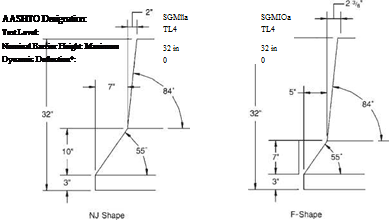Median Barrier Transitions
Transition sections are used between adjoining median barriers having significantly different deflection characteristics, between a semirigid median barrier and a rigid barrier (such as a bridge rail), and in similar situations. The transition sections should provide impact performance similar to standard sections, and emphasis should be placed on designs to avoiding vehicle snagging. Structural details of special importance include the following:
• Rail splices should develop the tensile strength of the weaker rail.
• Use a flared or sloped connection if the connection could snag an opposite-direction vehicle. Use a standard terminal connector to attach a W-beam or thrie-beam rail to a rigid bridge railing or parapet, or provide a recessed area in the parapet wall to receive the rail.
• In cases such as a strong-post W-beam transition to the concrete safety shape, use a blockout design and consider adding a rub rail or using a thrie-beam instead.
• Use a transition length 10 to 12 times the difference in lateral deflection of the two systems under consideration.
• Increase stiffness gradually from the weaker to the stronger system by means such as decreasing the post spacing, increasing the post size, and using nested sections of W-beam or thrie-beam.

Remarks: The concrete safety shapes are the only operational rigid barriers. The lower-sloped face redirects vehicles without damage under low-impact conditions. During moderate to severe impacts, some energy is dissipated when the vehicle is lifted off the pavement. The loss of tire contact with the pavement also aids redirection.
The details of the shape are critical. The distance from the pavement to the break between the upper and lower slopes should be kept at 13 in or below. Barrier performance under moderate to severe impact conditions is not significantly affected by overlays on the lower-sloped face, The overall height of the barrier, however, needs to be maintained at a minimum of 29 in.
The safety-shape barrier is suitable for narrow medians. Both faces can be flared away from the centerline to provide room for rigid objects to be installed in the medians.
*Very severe hits may destroy the barrier. Reinforcing is recommended to prevent shattering of concrete where the top of the barrier has a width less than 1 ft.
FIGURE 6.31 Concrete safety-shape median barrier. Conversion: 1 in = 25.4 mm. (From Roadside Design Guide, AASHTO, Washington, D. C., 2002 and 2004, with permission)






Leave a reply